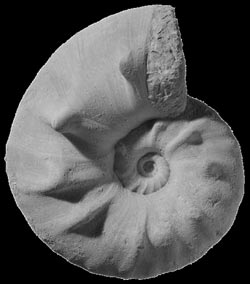Ups and downs of biodiversity after mass extinction

Amonoids peaked earlier after the vast mass extiction.<br>
Thanks to the cooler temperatures, the diversity of marine fauna ballooned, as paleontologists from the University of Zurich have reconstructed. The warmer climate, coupled with a high CO2 level in the atmosphere, initially gave rise to new, short-lived species. In the longer term, however, this climate change had an adverse effect on biodiversity and caused species to become extinct.
Until now, it was always assumed that it took flora and fauna a long time to recover from the vast mass extinction at the end of the Permian geological period 252 million years ago. According to the scientific consensus, complex ecological communities only began to reappear in the Middle Triassic, so 247 million years ago. Now, however, a Swiss team headed by paleontologist Hugo Bucher from the University of Zurich reveals that marine animal groups such as ammonoids and conodonts (microfossils) already peaked three or four million years earlier, namely still during the Early Triassic.
The scientists chart the temperature curves in detail in Nature Geoscience, demonstrating that the climate and the carbon dioxide level in the atmosphere fluctuated greatly during the Early Triassic and what impact this had on marine biodiversity and terrestrial plants.
Alternate cooler and very warm phases
For their climate reconstruction, Bucher and his colleagues analyzed the composition of the oxygen isotopes in conodonts, the remains of chordates that once lived in the sea. According to the study, the climate at the beginning of the Triassic 249 million years ago was cool. This cooler phase was followed by a brief very warm climate phase. At the end of the Early Triassic, namely between 247.9 and 245.9 million years ago, cooler conditions resumed.
Climate and carbon cycle influence biodiversity
The scientists then examined the impact of the climate on the development of flora and fauna. “Biodiversity increased most in the cooler phases,” explains paleontologist Bucher. “The subsequent extremely warm phase, however, led to great changes in the marine fauna and a major ecological shift in the flora.” Bucher and his team can reveal that this decline in biodiversity in the warm phases correlates with strong fluctuations in the carbon isotope composition of the atmosphere. These, in turn, were directly related to carbon dioxide gases, which stemmed from volcanic eruptions in the Siberian Large Igneous Province.
Species emerge and die out
Through the climatic changes, conodont and ammonoid faunae were initially able to recover very quickly during the Early Triassic as unusually short-lived species emerged. However, the removal of excess CO2 by primary producers such as algae and terrestrial plants had adverse effects in the long run: The removal of these vast amounts of organic matter used up the majority of the oxygen in the water. Due to the lack of oxygen in the oceans, many marine species died out. “Our studies reveal that greater climatic changes can lead to both the emergence and extinction of species. Thus, it is important to consider both extinction rates and the rate at which new species emerged,” says Bucher.
Bucher and his colleagues are convinced that climate changes and the emission of volcanic gases were key drivers of biotic recovery in the oceans during the Early Triassic: Cooler climate phases encourage biological diversification. Warmer climate phases and very high CO2 levels in the atmosphere, however, can have a harmful impact on biodiversity.
Literature:
Carlo Romano, Nicolas Goudemand, Torsten W. Vennemann, David Ware, Elke Schneebeli-Hermann, Peter A. Hochuli, Thomas Brühwiler, Winand Brinkmann, Hugo Bucher. Climatic and biotic upheavals following the end-Permian mass extinction. Nature Geoscience. DOI: 10.1038/NGEO1667
Contact:
Prof. Dr. Hugo Bucher
University of Zurich
Paleontological Institute and Museum
Tel. +41 44 634 23 44
E-Mail: hugo.fr.bucher@pim.uzh.ch
Media Contact
More Information:
http://www.uzh.chAll latest news from the category: Earth Sciences
Earth Sciences (also referred to as Geosciences), which deals with basic issues surrounding our planet, plays a vital role in the area of energy and raw materials supply.
Earth Sciences comprises subjects such as geology, geography, geological informatics, paleontology, mineralogy, petrography, crystallography, geophysics, geodesy, glaciology, cartography, photogrammetry, meteorology and seismology, early-warning systems, earthquake research and polar research.
Newest articles

Superradiant atoms could push the boundaries of how precisely time can be measured
Superradiant atoms can help us measure time more precisely than ever. In a new study, researchers from the University of Copenhagen present a new method for measuring the time interval,…

Ion thermoelectric conversion devices for near room temperature
The electrode sheet of the thermoelectric device consists of ionic hydrogel, which is sandwiched between the electrodes to form, and the Prussian blue on the electrode undergoes a redox reaction…

Zap Energy achieves 37-million-degree temperatures in a compact device
New publication reports record electron temperatures for a small-scale, sheared-flow-stabilized Z-pinch fusion device. In the nine decades since humans first produced fusion reactions, only a few fusion technologies have demonstrated…





















